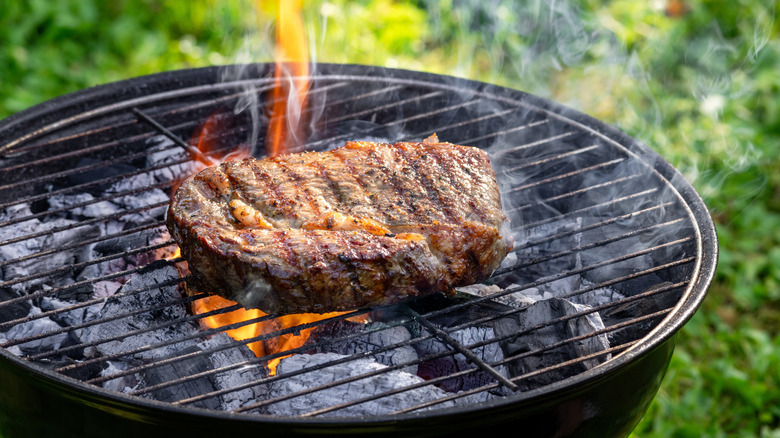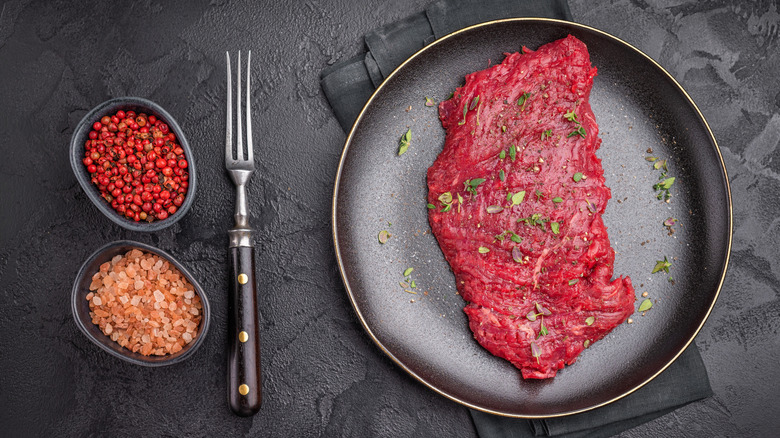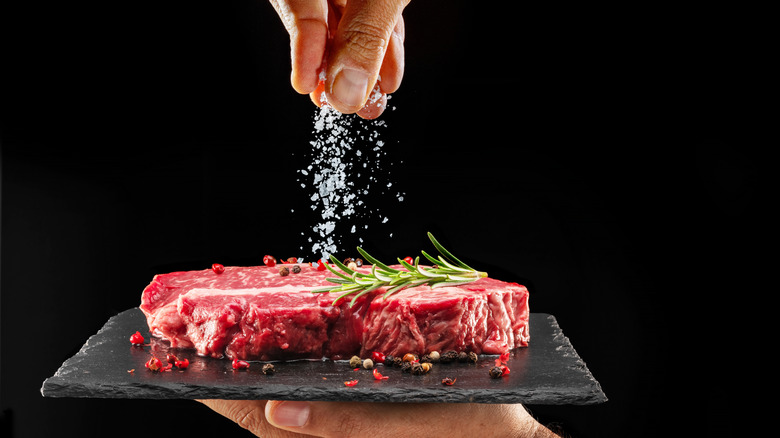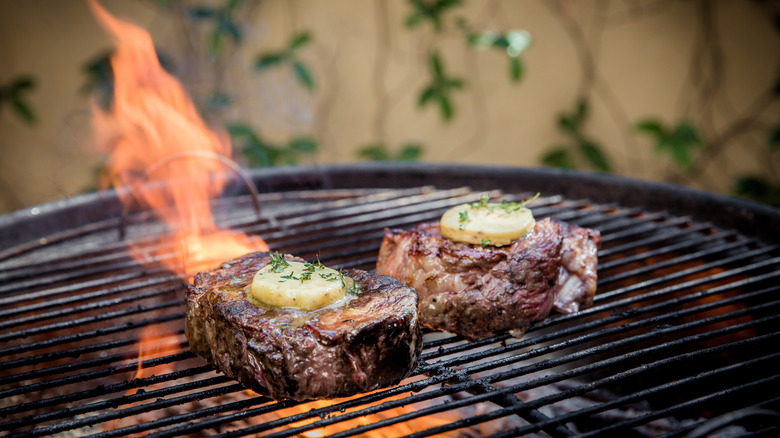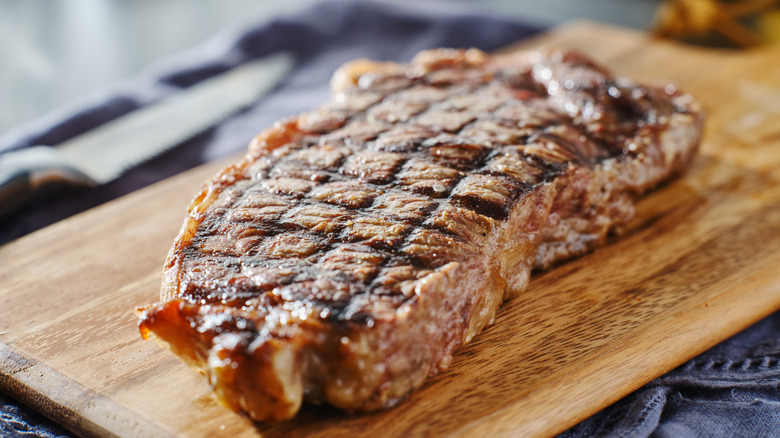How To Grill The Perfect Steak, According To Michael Symon - Exclusive
Like many of us, chef Michael Symon knew he needed to do something productive during the pandemic lockdown. In the summer of 2020, he started filming live cooking shows from his family home. Those hour-long videos quickly gained a huge following, and the project eventually grew into the Food Network show "Symon's Dinners Cooking Out." Just this month, Symon released his latest cookbook of the same name, and it's already making big waves with grill enthusiasts.
"Symon's Dinners Cooking Out: 100 Recipes That Redefine Outdoor Cooking" is all about delicious dishes that you can make on a standard charcoal grill. Of course, grilled meats feature heavily throughout the book, but there are also plenty of recipes for appetizers, side dishes, desserts, and even a cocktail section. While we're excited to pore over every section, we're also particularly interested in picking up some tips for cooking steak over charcoal.
For many people, charcoal grills are tricker to use than gas grills or the stove. First you have to get the coals white hot, then you need to manage the heat manually, and you have to know where to place the steaks so they cook evenly. Knowing that Symon is more than savvy when it comes to steak, we got in touch with him to find out how he grills his steaks and what advice he has for beginner grillers and seasoned pros alike. These are some of his tips for achieving the perfect grilled steak.
A charcoal grill is the way to go
What sets Michael Symon's latest cookbook apart from his previous publications is that every single recipe in the book (minus the cocktails) is designed to be cooked on a charcoal grill. One of the first things we asked him was whether he considered a charcoal grill superior to a gas grill when it comes to cooking steaks and he was adamant that he absolutely does. He told us, "There is a flavor you get cooking over live fire that just can't be matched on a gas grill."
While charcoal can give your meat a beautiful smoky flavor that you just don't get from a pan or gas grill, there's a common charcoal grilling mistake that can negate that. So many people turn to lighter fluid thinking it will be a quick, convenient way to get the coals going. However, that fluid can impart harsh chemical flavors into your food and ruin all that smoky flavor. Symon offers a better solution for starting your grill: a chimney starter. These hollow metal canisters hold the briquettes in place on the grill grate and shelter them. You simply light some wadded paper underneath the chimney and wait 10 to 15 minutes for the coals to get white hot, then pour them into your grill.
You don't need the most expensive cuts for a great steak
If you're familiar with Michael Symon's cooking shows and past cookbooks like "Michael Symon's Carnivore," then you probably know that he loves all types of steaks, from tender ribeyes to flavorful strip steaks and hearty porterhouses. However, in "Symon's Dinners Cooking Out," he revealed that the cuts he turns to most for grilling are flank steaks and skirt steaks. When we asked him why that was, he stated, "They're more affordable cuts that still pack big flavor."
Flank steak is a lean, boneless cut that comes from the cow's abdominal area. You may also see it labeled as London broil or jiffy steak. It's long, flat, and has a coarse grain running through it. Skirt steak is another long, flat cut that comes from the abdominal area of the cow under the ribs. It also has a coarse grain and often contains connective tissue. Both flank steak and skirt steak are rich and meaty, but need a bit of love to prevent them from turning out tough. A marinade can help tenderize the meat, and both turn out best when grilled quickly over high heat.
Salt your steak liberally and give it time to work its magic
Seasoning is an important step that can take your grilled steak from bland to brilliant. While there are many ways to impart extra flavor into your meat such as rubs and marinades, at the very least, you should be salting your steaks. Don't be afraid to be heavy handed with the salt either. According to Symon, underseasoning is one of the biggest mistakes people make when grilling steaks. You also want to give the salt ample time to absorb into the meat. "Salt them a couple hours before cooking if you have time," Symon advised.
As with many cooking techniques, there's a science behind why salting in advance can make your grilled steaks more tender and flavorful. As salt sits on the surface of the meat, it begins to draw water out. If you cook your steak while that water is still on the surface, it can prevent the Maillard reaction from happening. That's the process that turns the meat brown and gives it a lovely crust. However, after about 40 minutes or so, the salt begins to break down the proteins in the meat and the brine starts to reabsorb into the steak. The longer it sits, the more deeply it will penetrate the meat, giving it more flavor.
Know when to use direct heat vs. indirect heat
In the beginning of "Symon's Dinners Cooking Out," Symon goes into great detail about basic grill setups for different styles of cooking. The most important for grilling steaks are the direct heat and indirect heat setups. With the former, you simply spread the coals in an even layer in the grill so that the food on the grill gets constant high heat. The indirect heat setup involves placing the coals on just one side of the grill so that you have the option of cooking your food over high heat or moving it off the coals to cook at lower temperatures.
If you're planning on grilling medium to large cuts of steak, you want to set up the grill with the indirect heat method so that you can use a combination of both direct and indirect heat. "Use direct to get your hard sear and crust and then move to indirect when you close the lid to cook to preferred temperature," Symon told us. "This is especially important with thicker cuts." With thinner, tougher cuts like flank steaks and skirt steaks you may want to use just direct heat to quickly give the steaks a nice crust without drying them out too much.
Monitor the temperature carefully
There's nothing worse than grilling a beautiful piece of meat, only to cut into it and find that it's way off the mark in terms of the temperature you were going for. Underdone is not so bad because you can throw it back on the grill, but there's no going back from an overdone steak. Michael Symon's advice? "Use a thermometer. It's your best friend with thicker cuts." A meat thermometer is essential for charcoal grilling because you don't have the benefit of a built-in thermometer or dial to tell you how hot your grill actually is. Plus, different cuts cook at different rates.
While Symon doesn't recommend cooking thinner cuts above medium because they can become tough, thicker cuts are another story. With those, you can make your steak as rare or well-done as you like, and a meat thermometer can help you achieve perfection. The ideal steak temperatures are 120 to 125 degrees Fahrenheit for rare, 130 to 135 degrees for medium-rare, 140 to 145 degrees for medium, 150 to 155 degrees for medium-well, and 160 to 165 degrees for well-done. Keep in mind that your steak will continue to cook off the heat, so you want to remove it from the grill when it's about five to 10 degrees away from your goal temperature.
Resting is the key to tender, flavorful steak
So you've grilled what you believe is the perfect steak and just pulled it off the grill. You might be tempted to dive right in so that you can sample that delectable meat. However, according to Symon, cutting into meat right off the grill is a major mistake. He told us, "Make sure to let your steak rest after it is done." The reason being is that when the steak is hot, the muscle fibers contract and the juices are forced into the center. Cut into it right away, and those juices will pour out. By letting it rest, you give the fibers time to relax and the juices time to redistribute throughout the meat.
For the most succulent meat, rest your steak on a wooden cutting board after it comes off the grill. That way you'll be primed to cut into it after it's cooled down a bit. You can also tent it with a bit of tin foil if you're worried about it cooling down too much. Thinner steaks only need about 10 minutes to rest, while thicker cuts can benefit from resting times of about 20 minutes or more. You can also use a meat thermometer to help you determine when to cut your steak. Ideally, you want the center to cool down to about 120 to 130 degrees Fahrenheit
How you cut the steak matters
Resting isn't the only after-grill care you should be giving your steaks. How you cut your steak can also make a big difference in the texture. The first thing you want to do is identify the grain in your meat. This is the direction that the muscle fibers are running. You can identify it by the striations in your steaks. "Make sure to cut against the grain to ensure they are tender," Symon told us. Essentially, this means cutting your meat perpendicular to the striations instead of in the same direction that they're running.
The reason you want to cut against the grain is because it shortens the muscle fibers and makes them easier to chew. If you cut parallel to the grain, each bite you take will contain long fibers that are harder to break down. Shorter fibers means easier, more tender bites. Cutting against the grain is important for all cuts, but especially so for coarse cuts like flank steak and skirt steak. These cuts come from heavily worked muscles, which means they have more pronounced muscle fibers and connective tissue. If they're not sliced properly, they can feel overly chewy, even when cooked to the perfect temperature.
Don't neglect the sides
When many of us think of grilling, we tend to focus solely on meat. However, as Symon demonstrates in "Symon's Dinners Cooking Out," there are so many unique dishes you can cook on a charcoal grill that go beyond steaks and burgers, including a vast array of sides. In fact, Symon points out that home cooks often focus too narrowly on the main course. He believes that the sides are just as important to achieve the perfect steak dinner. "Steaks are so rich on their own, so pair them with bright, crisp lively sides," he advised,
You'll find tons of inspiration for vibrant side dishes in Symon's newly released cookbook. For example, he details how to grill asparagus perfectly so that it's crisp, but tender at the same time. The creamed corn with lime can add a pop of color to your plate and sweet and tangy notes that can play off the richness of the steak. He also has a great recipe for grilled greens with a tart lime vinaigrette. When choosing your sides, aim for flavors and textures that contrast with the steak's richness. Bright, acidic ingredients like citrus, vinegar, or fresh herbs can help cut through the fat, while crisp vegetables add freshness and crunch.
Batch cocktails are perfect for grill gatherings
Grilling is all about bringing people together, and the last thing you want is to be stuck inside mixing individual cocktails while everyone else enjoys the party. That's why batch cocktails are a game-changer for backyard gatherings. Instead of shaking up drinks one by one, you can prepare a big pitcher in advance, keeping it chilled and ready to serve. Symon and his wife, Liz, swear by this approach when they entertain, opting for large-format drinks that allow them to spend more time with friends and less time bartending.
When it comes to pairing cocktails with a grilled steak, Symon keeps it simple, but as for his spirit of choice? "Anything with bourbon, just because ... I love bourbon!" he told us. The notes of oak, caramel, and vanilla in the bourbon are a great match for the smoky, savory flavors of steak. For a bourbon-based drink that's also refreshing, consider whipping up a batch of whisky sours. The paper plane cocktail combines bourbon with Aperol, Amaro Nonino, and lemon juice for a vivid drink that will go down a treat with a grilled steak. And of course, the Old Fashioned is a classic that screams decadent steak dinner.

